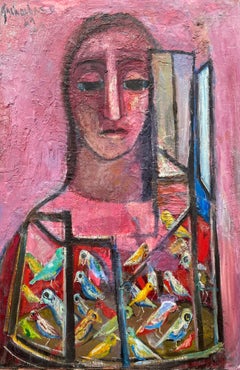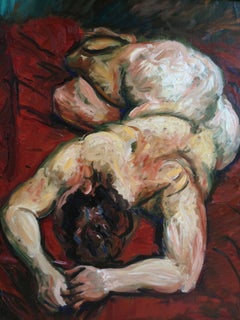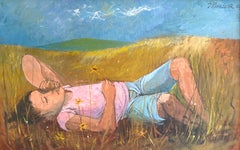Want more images or videos?
Request additional images or videos from the seller
1 of 9
Nahum Tschacbasov“Ships and Orbs”Circa 1955
Circa 1955
$1,440List Price
About the Item
- Creator:Nahum Tschacbasov (1899-1984, American)
- Creation Year:Circa 1955
- Dimensions:Height: 10 in (25.4 cm)Width: 12 in (30.48 cm)Depth: 0.25 in (6.35 mm)
- Medium:
- Movement & Style:
- Period:
- Condition:
- Gallery Location:Southampton, NY
- Reference Number:1stDibs: LU1418191042
About the Seller
5.0
Platinum Seller
Premium sellers with a 4.7+ rating and 24-hour response times
Established in 1977
1stDibs seller since 2013
558 sales on 1stDibs
Authenticity Guarantee
In the unlikely event there’s an issue with an item’s authenticity, contact us within 1 year for a full refund. DetailsMoney-Back Guarantee
If your item is not as described, is damaged in transit, or does not arrive, contact us within 7 days for a full refund. Details24-Hour Cancellation
You have a 24-hour grace period in which to reconsider your purchase, with no questions asked.Vetted Professional Sellers
Our world-class sellers must adhere to strict standards for service and quality, maintaining the integrity of our listings.Price-Match Guarantee
If you find that a seller listed the same item for a lower price elsewhere, we’ll match it.Trusted Global Delivery
Our best-in-class carrier network provides specialized shipping options worldwide, including custom delivery.You May Also Like
“Central Park in Winter, 1949” Manhattan New York City Snow Day Sleds Children
Located in Yardley, PA
With a studied hand, Sloan captures the human theater of a snow-covered Central Park filled with bundled-up New Yorkers, sledding, walking, chatting, and caring for children. The exp...
Category
1940s American Modern Landscape Paintings
Materials
Tempera, Oil, Masonite
$5,500
H 29.75 in W 35.75 in D 2 in
"Georgia Moonshiner, c. 1935" by Athos Menaboni (1895-1990) American WPA Era Oil
Located in Yardley, PA
A fantastic WPA-era painting of a Georgia moonshiner by famed Italian-American artist Athos Menaboni (1895-1990).
This work depicts an older man sporting a brown hat, brown jacket, ...
Category
1930s American Modern Figurative Paintings
Materials
Masonite, Oil
$3,950
H 20 in W 18 in D 2 in
The Magician oil and tempera painting by Julio de Diego
By Julio de Diego
Located in Hudson, NY
Julio De Diego’s Atomic Series paintings made an extraordinary statement regarding the shock and fear that accompanied the dawn of the nuclear age. In the artist’s own words, “Scientists were working secretly to develop formidable powers taken from the mysterious depths of the earth - with the power to make the earth useless! Then, the EXPLOSION! . . . we entered the Atomic Age, and from there the neo-Atomic war begins. Explosions fell everywhere and man kept on fighting, discovering he could fight without flesh.”
To execute these works, De Diego developed a technique of using tempera underpainting before applying layer upon layer of pigmented oil glazes. The result is paintings with surfaces which were described as “bonelike” in quality. The forms seem to float freely, creating a three-dimensional visual effect. In the 1954 book The Modern Renaissance in American Art, author Ralph Pearson summarizes the series as “a fantastic interpretation of a weighty theme. Perhaps it is well to let fantasy and irony appear to lighten the devastating impact. By inverse action, they may in fact increase its weight.”
Exhibited
1964 Marion Koogler McNay Art Institute, San Antonio, Texas
This work retains its original frame which measures 54" x 42" x 2"
About this artist: Julio De Diego crafted a formidable persona within the artistic developments and political struggles of his time. The artist characterized his own work as “lyrical,” explaining, “through the years, the surrealists, the social-conscious painters and the others tried to adopt me, but I went my own way, good, bad or indifferent.” [1] His independence manifested early in life when de Diego left his parent’s home in Madrid, Spain, in adolescence following his father’s attempts to curtail his artistic aspirations. At the age of fifteen he held his first exhibition, set up within a gambling casino. He managed to acquire an apprenticeship in a studio producing scenery for Madrid’s operas, but moved from behind the curtains to the stage, trying his hand at acting and performing as an extra in the Ballet Russes’ Petrouchka with Nijinsky. He spent several years in the Spanish army, including a six-month stretch in the Rif War of 1920 in Northern Africa. His artistic career pushed ahead as he set off for Paris and became familiar with modernism’s forays into abstraction, surrealism, and cubism.
The artist arrived in the U.S. in 1924 and settled in Chicago two years later. He established himself with a commission for the decoration of two chapels in St. Gregory’s Church. He also worked in fashion illustration, designed magazine covers and developed a popular laundry bag for the Hotel Sherman. De Diego began exhibiting through the Art Institute of Chicago in 1929, and participated in the annual Chicago Artists Exhibitions, Annual American Exhibitions, and International Water Color Exhibitions. He held a solo exhibition at the Art Institute of Chicago in the summer of 1935. Though the artist’s career was advancing, his family life had deteriorated. In 1932 his first marriage dissolved, and the couple’s young daughter Kiriki was sent to live with friend Paul Hoffman.
De Diego continued to develop his artistic vocabulary with a growing interest in Mexican art. He traveled throughout the country acquainting himself with the works of muralists such as Carlos Merida, and also began a collection of small native artifacts...
Category
1940s American Modern Abstract Paintings
Materials
Masonite, Oil, Tempera
St. Atomic oil and tempera painting by Julio de Diego
By Julio de Diego
Located in Hudson, NY
Julio De Diego’s Atomic Series paintings made an extraordinary statement regarding the shock and fear that accompanied the dawn of the nuclear age. In the artist’s own words, “Scientists were working secretly to develop formidable powers taken from the mysterious depths of the earth - with the power to make the earth useless! Then, the EXPLOSION! . . . we entered the Atomic Age, and from there the neo-Atomic war begins. Explosions fell everywhere and man kept on fighting, discovering he could fight without flesh.”
To execute these works, De Diego developed a technique of using tempera underpainting before applying layer upon layer of pigmented oil glazes. The result is paintings with surfaces which were described as “bonelike” in quality. The forms seem to float freely, creating a three-dimensional visual effect. In the 1954 book The Modern Renaissance in American Art, author Ralph Pearson summarizes the series as “a fantastic interpretation of a weighty theme. Perhaps it is well to let fantasy and irony appear to lighten the devastating impact. By inverse action, they may in fact increase its weight.”
Exhibited
1950 University of Illinois at Urbana "Contemporary American Painting"
1964 Marion Koogler McNay Art Institute, San Antonio, Texas
This work retains its original frame which measures 54" x 36" x 2".
About this artist: Julio De Diego crafted a formidable persona within the artistic developments and political struggles of his time. The artist characterized his own work as “lyrical,” explaining, “through the years, the surrealists, the social-conscious painters and the others tried to adopt me, but I went my own way, good, bad or indifferent.” [1] His independence manifested early in life when de Diego left his parent’s home in Madrid, Spain, in adolescence following his father’s attempts to curtail his artistic aspirations. At the age of fifteen he held his first exhibition, set up within a gambling casino. He managed to acquire an apprenticeship in a studio producing scenery for Madrid’s operas, but moved from behind the curtains to the stage, trying his hand at acting and performing as an extra in the Ballet Russes’ Petrouchka with Nijinsky. He spent several years in the Spanish army, including a six-month stretch in the Rif War of 1920 in Northern Africa. His artistic career pushed ahead as he set off for Paris and became familiar with modernism’s forays into abstraction, surrealism, and cubism.
The artist arrived in the U.S. in 1924 and settled in Chicago two years later. He established himself with a commission for the decoration of two chapels in St. Gregory’s Church. He also worked in fashion illustration, designed magazine covers and developed a popular laundry bag for the Hotel Sherman. De Diego began exhibiting through the Art Institute of Chicago in 1929, and participated in the annual Chicago Artists Exhibitions, Annual American Exhibitions, and International Water Color Exhibitions. He held a solo exhibition at the Art Institute of Chicago in the summer of 1935. Though the artist’s career was advancing, his family life had deteriorated. In 1932 his first marriage dissolved, and the couple’s young daughter Kiriki was sent to live with friend Paul Hoffman.
De Diego continued to develop his artistic vocabulary with a growing interest in Mexican art. He traveled throughout the country acquainting himself with the works of muralists such as Carlos Merida, and also began a collection of small native artifacts...
Category
1940s American Modern Abstract Paintings
Materials
Masonite, Oil, Tempera
Inevitable Day – Birth of the Atom oil and tempera painting by Julio De Diego
By Julio de Diego
Located in Hudson, NY
Julio De Diego’s Atomic Series paintings made an extraordinary statement regarding the shock and fear that accompanied the dawn of the nuclear age. In the artist’s own words, “Scientists were working secretly to develop formidable powers taken from the mysterious depths of the earth - with the power to make the earth useless! Then, the EXPLOSION! . . . we entered the Atomic Age, and from there the neo-Atomic war begins. Explosions fell everywhere and man kept on fighting, discovering he could fight without flesh.”
To execute these works, De Diego developed a technique of using tempera underpainting before applying layer upon layer of pigmented oil glazes. The result is paintings with surfaces which were described as “bonelike” in quality. The forms seem to float freely, creating a three-dimensional visual effect. In the 1954 book The Modern Renaissance in American Art, author Ralph Pearson summarizes the series as “a fantastic interpretation of a weighty theme. Perhaps it is well to let fantasy and irony appear to lighten the devastating impact. By inverse action, they may in fact increase its weight.”
Bibliography
Art in America, April 1951, p.78
About this artists: Julio De Diego crafted a formidable persona within the artistic developments and political struggles of his time. The artist characterized his own work as “lyrical,” explaining, “through the years, the surrealists, the social-conscious painters and the others tried to adopt me, but I went my own way, good, bad or indifferent.” [1] His independence manifested early in life when de Diego left his parent’s home in Madrid, Spain, in adolescence following his father’s attempts to curtail his artistic aspirations. At the age of fifteen he held his first exhibition, set up within a gambling casino. He managed to acquire an apprenticeship in a studio producing scenery for Madrid’s operas, but moved from behind the curtains to the stage, trying his hand at acting and performing as an extra in the Ballet Russes’ Petrouchka with Nijinsky. He spent several years in the Spanish army, including a six-month stretch in the Rif War of 1920 in Northern Africa. His artistic career pushed ahead as he set off for Paris and became familiar with modernism’s forays into abstraction, surrealism, and cubism.
The artist arrived in the U.S. in 1924 and settled in Chicago two years later. He established himself with a commission for the decoration of two chapels in St. Gregory’s Church. He also worked in fashion illustration, designed magazine covers and developed a popular laundry bag for the Hotel Sherman. De Diego began exhibiting through the Art Institute of Chicago in 1929, and participated in the annual Chicago Artists Exhibitions, Annual American Exhibitions, and International Water Color Exhibitions. He held a solo exhibition at the Art Institute of Chicago in the summer of 1935. Though the artist’s career was advancing, his family life had deteriorated. In 1932 his first marriage dissolved, and the couple’s young daughter Kiriki was sent to live with friend Paul Hoffman.
De Diego continued to develop his artistic vocabulary with a growing interest in Mexican art. He traveled throughout the country acquainting himself with the works of muralists such as Carlos Merida, and also began a collection of small native artifacts...
Category
1940s American Modern Abstract Paintings
Materials
Masonite, Oil, Tempera
Neon Lighting WPA Mid 20th Century Social Realism American Scene Modern Figures
By Maurice Becker
Located in New York, NY
Neon Lighting WPA Mid 20th Century Social Realism American Scene Modern Figures
MAURICE BECKER (1889-1975)
'Neon Lighting
17 1/4 x 13 3/4 inches
Oil on masonite
Signed, dated 1936 and titled on verso
BIO
Maurice Becker, painter, political cartoonist and social reformer, was born in 1889 either in Gorky or Niznij Novgorod, in Russia. His family came to the United States in 1892, to New York City. After high school, Becker worked in a clothing factory. He studied with Ash Can School artist Robert Henri in 1908, and exhibited in the famous 1913 Armory Show in New York City when he was only twenty-four years of age.
At the Armory show, Becker showed a drawing of a dog's head...
Category
1930s American Modern Figurative Paintings
Materials
Masonite, Oil
$3,000
H 25 in W 21 in D 3 in
A Soulful Modernist Portrait
By Boris Deutsch
Located in San Francisco, CA
On offer is a portrait of an unknown sitter who is rendered with profound dignity yet lifted from gloomy solemnity by a vibrant and intriguing background. Notably, artist Boris Deuts...
Category
1950s American Modern Portrait Paintings
Materials
Masonite, Oil
Pensive With Nosegay Mid Century Modern Oil Painting
Located in Lake Worth Beach, FL
Pensive with nosegay -
Painted in Berkeley CA. painting size 10x8 with frame 16x14x1
Jon (Corka) Cornin 1905-1992
Born in New York City on March 24, 1905, Jon Cornin studied in Ne...
Category
1950s American Modern Figurative Paintings
Materials
Masonite, Oil
$1,200
H 16 in W 14 in D 1 in
"Jersey City Lofts" Lois Dodd, Plein-Air, Modernist American Urban Landscape
Located in New York, NY
Lois Dodd
Jersey City Lofts, 1998
Signed and dated to lower right; signed, titled and dated to the reverse
Oil on Masonite
10 x 13 inches
Provenance
The artist
Private Collection (g...
Category
1990s American Modern Figurative Paintings
Materials
Masonite, Oil
Mervin Jules Folk Singer Portrait, Signed
By Mervin Jules
Located in New York, NY
Mervin Jules (American, 1912-1994)
Folk Singer, 20th century
Oil on masonite
18 x 7 1/2 in.
Signed lower left: Jules
Provenance: Garelick's Gallery, Detroit
Matte included, no fram...
Category
20th Century American Modern Figurative Paintings
Materials
Masonite, Oil
More From This Seller
View All“Woman and Birds”
By Nahum Tschacbasov
Located in Southampton, NY
Mid-century oil on masonite modern painting by the well known Russian/American artist, Nahum Tschacbasov. Signed top left and dated 1949. Titled verso. Condition is fair. Provenanc...
Category
1940s American Modern Figurative Paintings
Materials
Masonite, Oil
$4,600 Sale Price
20% Off
“Reclining Nude”
By Jacques Koslowsky
Located in Southampton, NY
Oil on canvas
Signed verso
Category
1960s American Modern Figurative Paintings
Materials
Canvas, Oil
$1,280 Sale Price
41% Off
“Family”
By Hazel Finck
Located in Southampton, NY
Oil on canvas. Signed and dated lower right 1930
Biography Hazel Finck
Born in New Haven, Connecticut, Hazel Finck studied art with Guy Wiggins and Sigismund Ivanowski, a Russi...
Category
1930s American Modern Paintings
Materials
Canvas, Oil
“Girl in the Grass”
By Anton Refregier
Located in Southampton, NY
Original oil on canvas painting by Anton Refregier of a young girl resting in the grass. Signed upper right and dated 1962. Condition is very good. The painting is in its original oa...
Category
1960s American Modern Figurative Paintings
Materials
Canvas, Oil
$1,875 Sale Price
33% Off
"View in the Court of Rue Du' Jardinet"
By Alvin Robert Raffel
Located in Southampton, NY
Here for your consideration is a oil on academy board painting by the American artist, Alvin Raffel. Signed and titled verso. Circa 1930's. Condition is good. Small puncture in the ...
Category
1930s American Modern Figurative Paintings
Materials
Oil
$600 Sale Price
20% Off
"View in the Court of Rue Du' Jardinet"
By Alvin Robert Raffel
Located in Southampton, NY
Here for your consideration is a oil on academy board painting by the American artist, Alvin Raffel. Signed and titled verso. Circa 1930's. Condition is good. Small puncture in the ...
Category
1930s American Modern Figurative Paintings
Materials
Oil
$577 Sale Price
23% Off



